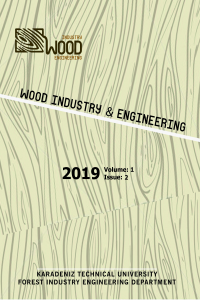Öz
Kaynakça
- Baltalar H. (2006). Kurumsal İnovasyon ve İnovasyonun Kurumsallaşması, Mobilya Sanayinde İnovasyon Uygulamaları Bildiri Kitabı, Eskişehir, p.
- Brem A. and Voigt K. (2009). Integration of market pull and technology push in the corporate front end and innovation management-Insights from the German software industry, Technovation, 29(5): p. 351-367.
- Cao X. (2004). Innovation in China's furniture industry, Oregon, Oregon State University.
- Çetin G. (2017). İnovasyon Nedir? Accessed 02.07.2017, http://www.guvencetin.com/inovasyon/.
- European Commission Furniture Industry. (2017). Accessed 17.07.2017, https://ec.europa.eu/growth/sectors/raw-materials/industries/forest-based/furniture_en.
- Gök. A. (2002). Frascati Kılavuzu Işığında Ar-Ge, TÜBİTAK, Ankara.
- Işık Ö. and Satı E. (2017). İnovasyon ve Marka Yönetimi Etkileşimi: Mobilya Sektöründe MOSDER Üyesi Firmalara Yönelik Bir Araştırma, Akademik Bakış Dergisi, 38, Accessed 20.07.2017.
- Karayılmazlar S. et al. (2006). İnovasyon Kavramına Bir Bakış; Türkiye’de İnovasyon, Mobilya Sanayinde İnovasyon Uygulamaları Bildiri Kitabı, Eskişehir, p.
- Kavrakoğlu İ. (2016). Yönetimde Devrimin Rehberi İnovasyon, İstanbul, Alteo Yayıncılık, p. 101-102.
- Orta Anadolu İhracatçı Birlikleri Genel Sekreterliği. (2016). Mobilya Sektör Raporu, Ankara.
- Oslo Manual. (2006). Yenilik Verilerinin Toplanması ve Yorumlanması İçin İlkeler, OECD, Avrupa Birliği. Smart Bed: "MedBed". (2015). Accessed 14.08.2017, http://orman.istanbul.edu.tr/?p=11391.Taşkın E. (2014). Mobilya Sanayi İşletmelerinde Yenilik Yönetimi ve Süreç Yenilikçiliği İncelemesi, 14. Üretim Araştırmaları Sempozyumu Bildiri Kitabı, İstanbul, p. 223-234.
- Tunçel S. (2017). Üretim Sistemlerinde Bütünleşik Yapı ve İnovasyon, Accessed 20.07.2017, www.sabittuncel.com.
- Yavuz Ç. (2010). İşletmelerde İnovasyon-Performans İlişkisinin İncelenmesine Dönük Bir Çalışma, Girişimcilik ve Kalkınma Dergisi: p. 144-173.
Öz
For businesses to act in accordance with the developing technology will
enable them to differentiate from their competitors with innovative approaches
in a competitive environment. In addition to competitive elements such as cost,
aesthetics, functionality, etc., all the innovative approaches of a business
from design to final product are also an important mechanism in getting the
edge over the competition.
Innovative thinking has different and important effects on the development
of business models. Traditional revenue models involve unforeseen risks. For
example, wrong and weak preferences that may occur in the parameters such as
selection of job type and job site, determination of target group, pricing
policy etc. can cause the related business model to fail. It is, however,
possible to prevent financial losses by exhibiting the innovative approaches
that minimize these risks.
In order businesses to survive, it has become essential to maximize their
profitability because of the high-ranking competition as a result of the global
economy. In this context, the businesses that operate efficiently are able to
achieve the desired profit margins. Otherwise it has become nearly impossible
for them to survive.
In the wood industry, the final products are produced by passing the raw
material obtained from forest resources through various processes. Within all
this complex structure, the businesses often suffer financial losses or cannot
take huge leaps because of traditional habits. Apart from this, the handling of
production processes and marketing the products with a new perspective form an
important basis for the economic breakthroughs.
Within the framework of this academic research, the effects of the
innovative methods and the transformations that these methods would bring in to
the wood industry besides its traditional structure are examined.
Anahtar Kelimeler
Kaynakça
- Baltalar H. (2006). Kurumsal İnovasyon ve İnovasyonun Kurumsallaşması, Mobilya Sanayinde İnovasyon Uygulamaları Bildiri Kitabı, Eskişehir, p.
- Brem A. and Voigt K. (2009). Integration of market pull and technology push in the corporate front end and innovation management-Insights from the German software industry, Technovation, 29(5): p. 351-367.
- Cao X. (2004). Innovation in China's furniture industry, Oregon, Oregon State University.
- Çetin G. (2017). İnovasyon Nedir? Accessed 02.07.2017, http://www.guvencetin.com/inovasyon/.
- European Commission Furniture Industry. (2017). Accessed 17.07.2017, https://ec.europa.eu/growth/sectors/raw-materials/industries/forest-based/furniture_en.
- Gök. A. (2002). Frascati Kılavuzu Işığında Ar-Ge, TÜBİTAK, Ankara.
- Işık Ö. and Satı E. (2017). İnovasyon ve Marka Yönetimi Etkileşimi: Mobilya Sektöründe MOSDER Üyesi Firmalara Yönelik Bir Araştırma, Akademik Bakış Dergisi, 38, Accessed 20.07.2017.
- Karayılmazlar S. et al. (2006). İnovasyon Kavramına Bir Bakış; Türkiye’de İnovasyon, Mobilya Sanayinde İnovasyon Uygulamaları Bildiri Kitabı, Eskişehir, p.
- Kavrakoğlu İ. (2016). Yönetimde Devrimin Rehberi İnovasyon, İstanbul, Alteo Yayıncılık, p. 101-102.
- Orta Anadolu İhracatçı Birlikleri Genel Sekreterliği. (2016). Mobilya Sektör Raporu, Ankara.
- Oslo Manual. (2006). Yenilik Verilerinin Toplanması ve Yorumlanması İçin İlkeler, OECD, Avrupa Birliği. Smart Bed: "MedBed". (2015). Accessed 14.08.2017, http://orman.istanbul.edu.tr/?p=11391.Taşkın E. (2014). Mobilya Sanayi İşletmelerinde Yenilik Yönetimi ve Süreç Yenilikçiliği İncelemesi, 14. Üretim Araştırmaları Sempozyumu Bildiri Kitabı, İstanbul, p. 223-234.
- Tunçel S. (2017). Üretim Sistemlerinde Bütünleşik Yapı ve İnovasyon, Accessed 20.07.2017, www.sabittuncel.com.
- Yavuz Ç. (2010). İşletmelerde İnovasyon-Performans İlişkisinin İncelenmesine Dönük Bir Çalışma, Girişimcilik ve Kalkınma Dergisi: p. 144-173.
Ayrıntılar
| Birincil Dil | İngilizce |
|---|---|
| Konular | Malzeme Karekterizasyonu |
| Bölüm | Review Articles |
| Yazarlar | |
| Yayımlanma Tarihi | 25 Aralık 2019 |
| Kabul Tarihi | 3 Aralık 2019 |
| Yayımlandığı Sayı | Yıl 2019 Cilt: 1 Sayı: 2 |


